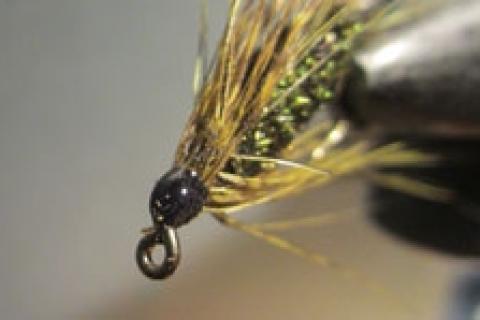
 |
| Notice how there's nothing blocking the eye of this Carey Special? |
Many years ago, my buddy and I were fishing a local brook trout river when, without much warning, fish started rising all around us. Suddenly, caddis flies were everywhere, bouncing over the water like little puppets held aloft by microscopic strings.
I was relatively new to the sport back then, but even I knew that I should try to match the hatch. So, I quickly brought in my line, reached for a fly box and pulled out a deer hair caddis I had previously tied in approximately the same size and color. Then, I spent the next five minutes cursing as I tried desperately to thread my tippet through the eye of the hook.
That was a long, long time ago, so my difficulties had nothing to do with middle-aged eyesight. Instead, it had everything to do with poor fly tying techniques. You see, I was also new at fly tying, and I had crowded the eye of that hook too closely.
For those new to the pastime, crowding the eye is a term used by fly tyers to describe when thread or material is wrapped so far forward that it encroaches on the opening in the eye of the hook. The most obvious problem this causes is blocking the eye so that tying the fly onto your tippet is difficult at best and impossible at worst.
A crowded eye can also indicate that proportions on the fly you are out of whack — yes, it's an aesthetic thing, but let's face it, no one likes a poorly tied fly.
Luckily, remedying this is easy.
The most basic rule (and the one most often forgotten by new tyers) is to stop laying down your thread base on the hook at least one, better still two, eye widths back from the eye. This gives you plenty of room to build a head and attach the appropriate material so that you don't have to crowd the eye. You can also make smaller, more compact heads on your flies by using the finest thread appropriate to the pattern and its size. If you can get away with an 8/0 thread instead of a 6/0, you'll obviously be able to make a smaller head with the same amount of wraps. It just takes practice to get the feel of the finer thread.
I also find that a whip finishing tool, used correctly, allows me to make smaller, tighter heads and really control where the thread is being laid down. Once you get the hang of using one, you'll wonder why you waited this long.
After that, there's only one thing left to do. Once you cemented the head of your new fly, make sure you stick a bodkin through the eye to ensure it is clear of glue before finding a place for it in your fly box. The last thing you want to discover is that the eye is cemented over when you need the fly most.
This is a little detail, but in fly tying and fly fishing, the little things truly matter. So keep your eyes open and save yourself some trouble.
- 3383 views

